Last Updated on August 10, 2025 by Michelle
Long before I ever started grinding wheat berries into flour, I made sourdough bread.
Yes, I made sourdough long before 2020. But when I started milling my own flour, I struggled to make sourdough.
As it turns out, using the right wheat berries for sourdough bread is half the battle. So let’s talk about wheat berries and sourdough bread.
Why use wheat berries for sourdough bread?
If you’re making fresh sourdough bread for your family, chances are you’re concerned about eating well. And simply put, flour from the store is old and dead. Which means that nutrients you could and should be gaining from eating flour are sifted, heated, and treated away until they simply don’t exist in the flour anymore.
Wheat berries are the wholegrain, unground version of flour. When you grind wheat berries, you get flour. And when you use that flour quickly after milling, you’re offering your body flour in it’s most nutritious and pure form.
Sourdough bread made with fresh flour (made from milling wheat berries) is simply more nutritious than sourdough made with any other flour.
Plus, milling your own wheat berries allows you to try different types of flour (therefore different flavors) in your sourdough.
Not to mention that milling your own flour is often cheaper than purchasing flour (especially if you’re purchasing high-quality flour that can get pricy!). I share my cost analysis in this article: Why I Started Milling My Own Flour.
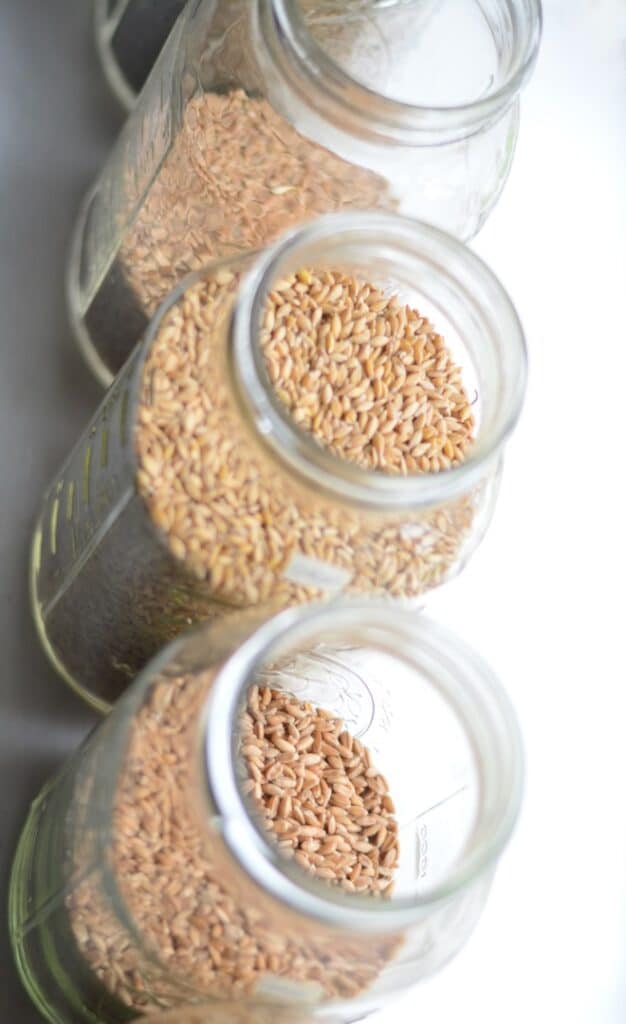
Fresh ground flour for sourdough
Fresh flour can be tough to work with, especially if you’re not used to whole grains. And sourdough bread can be like a puzzle to figure out and understand if you’re new to it. So when you combine fresh flour (made by grinding wheat berries) and sourdough together, sometimes it can feel like one big science experiment. But by implementing a few tips and tricks you’ll be a pro in no time.
- Try using natural dough enhancers to give you a better end result. Vital wheat gluten is a good one, sunflower lecithin works, or adding a tangzhong can help improve texture. Also try adding enhancers like egg yolks, fats, and sweeteners. All of these will help soften/improve the texture of the dough.
- Don’t be afraid to knead your sourdough. I know there are lots of “no-knead” sourdough recipes, but if you want good bread, you need strong gluten. Strong gluten is developed by kneading the dough.
- Use recipes you already know and love, if possible. Incorporating fresh flour into sourdough can be daunting, but it’s much easier if you already know the recipe, how the dough should look and feel, and what the timeline should look like. Recipes you’ve made many times before will simply give you better results.
- Don’t be afraid to use 50/50 fresh flour from wheat berries and white flour from the store. You’ll still be getting nutrients and getting a feel for fresh flour, but you’ll get better rise and texture as you learn the ins and outs of using wholegrain flour in sourdough bread.
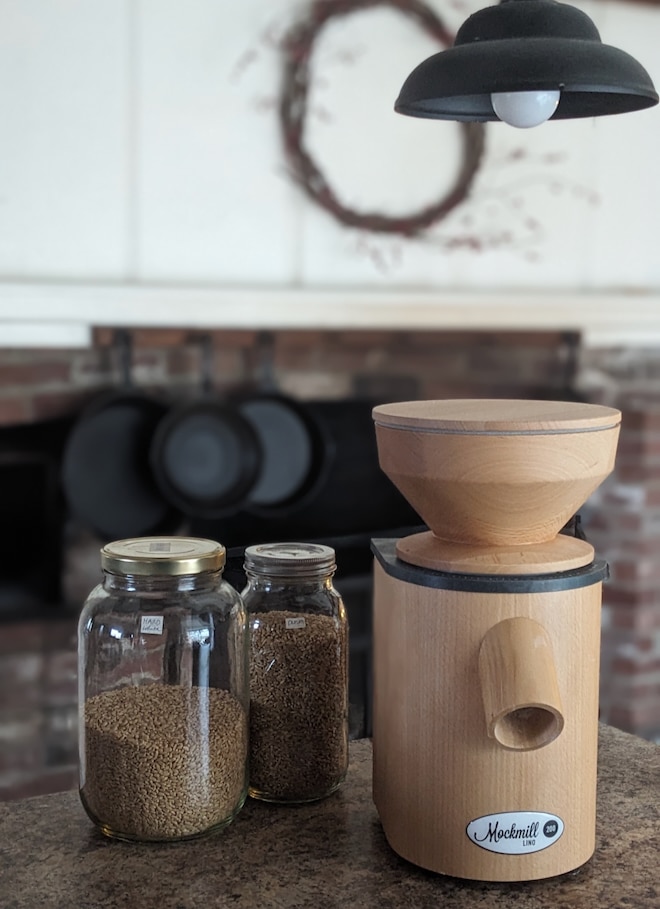
How to use wheat berries and fresh flour in sourdough bread
Technically using wheat berries to make sourdough bread is as simple as grinding the wheat berries into flour and using that flour to make bread. Make sure you’re using the right wheat berries, and that you’re using a good grain mill that will make fine flour.
See my Ultimate Guide to Choosing a Grain Mill for all the questions to ask when you’re choosing your family’s mill.
You will find a few differences, though, when working with sourdough made from wheat berries/fresh flour, and working with flour from the store.
First of all, fresh milled flour hasn’t been sifted, so it contains the bran and germ. These are “sharp” in the dough, causing some of the gluten strands to be “cut.” No need to fret, but if your doughs don’t rise quite as much as usual, you’ll know why. The bran is nutritious and flavorful, but it does tend to interfere with gluten development, which is part of why loaves made with fresh flour can be denser than their white flour counterparts.
Second, you might find that your doughs proof or ferment faster than you’re used to. You’re not crazy–that’s because fresh flour is so “alive” with nutrients that the yeast in the dough has more to feed off of and eats it up faster–causing the dough to rise faster.
Finally, your hydrations will probably be different than what you’re used to. Fresh flour tends to soak up water more slowly than conventional flour. Which means that it’s easy to add too much flour and have a dry dough. But I’ve also seen folks so scared to add “too much flour” that they’re basically working with muffin batter. Dough that’s too dry and dough that’s too runny will both result in bad bread.
What wheat berries to use for sourdough
Given that there are a seemingly endless amount of wheat berry types, I was super intimidated by choosing what wheat berry to use for a very long time. And if you’re looking for a breakdown of all the types of wheat berries and which ones to use for what, checkout this guide to choosing the right wheat berries.
For sourdough, your best bet is probably going to be either hard red wheat or hard white wheat. NEVER use soft white wheat for bread, as it won’t be able to develop gluten. Soft wheats are used for pastries, baked goods, and more delicate things that don’t develop gluten.
Other grains like spelt, einkorn, kamut, rye, or durum can be used to make sourdough bread, but especially if you’re starting out with wheat berries and sourdough, I’d stick with either hard red or hard white wheat.
To feed my starter, I personally like to use rye flour, but almost any fresh flour will work for feeding your starter.
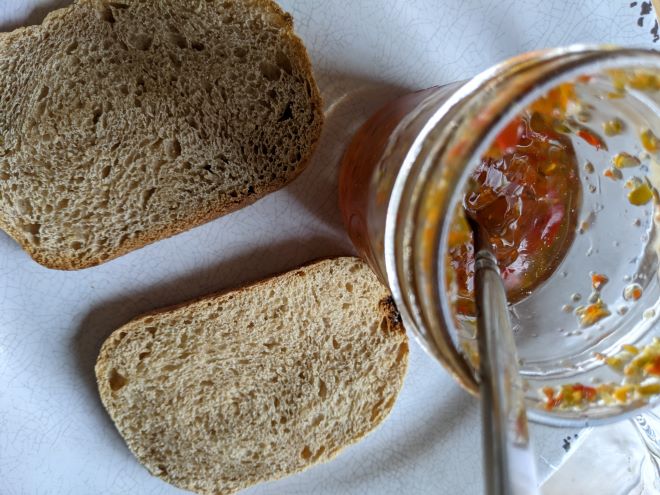
Hard white wheat and hard red wheat for sourdough bread
Folks often seem confused about the different between red and white wheat.
Truthfully, I use hard red wheat and hard white wheat interchangeably, without noticing much difference. I tend to lean more towards using hard red wheat more often, because it tends to be cheaper.
They’re very similar, but hard red wheat just has a darker color and deeper flavor than hard white wheat. If you’re not used to the flavors of fresh flour and whole grains, I’d recommend starting out with hard white wheat for breads. It has a slightly sweeter flavor and slightly lighter color than hard red.
Can you use soft white wheat berries for sourdough bread?
Using soft white wheat berries for sourdough bread isn’t recommended. It’s low in protein (compared to hard wheats), and doesn’t have good gluten potential. That means that the gluten (that we need for good bread!) in your dough simply won’t develop the way it should.
Stick to hard wheats (or ancient grains) for sourdough, or any bread for that matter. Save the hard white for muffins, pastries, some cookies, cakes, and other baked goods. Soft white wheat berries will work well for anything that you don’t want to develop gluten in. For example, if too much gluten forms in your muffins (sometimes caused by overmixing), they’ll be gummy, tough, chewy, or just generally not very good.
The same gluten that we need for good, soft, fluffy bread, we can’t have in muffins, cookies, or cakes, or they’ll be the wrong texture.

Should I sift fresh milled flour for sourdough?
Overall, I try to convince people to sift their fresh flour as little as possible because the stuff you sift out (the bran & germ) are truly the good stuff. They contain so many nutrients, tons of fiber, and lots of good fats. But there are a some times when sifting your fresh milled flour just makes your life easier:
- Sift fresh milled flour if your mill isn’t that great or you ‘re using a blender or appliance other than a grain mill to make your flour. If your flour is very course, you’ll have a very hard time making tasty things with it.
- Sift fresh flour if you’re going to add the bran & germ back in after. I personally still skip this step because it dirties an extra dish (the sieve) and just adds an extra step in general, but there are benefits to sifting fresh milled flour just to aerate it, then add the bran and germ back in (so you don’t miss their nutrients).
- Sift fresh flour if you’re making something really delicate or sensitive. Like if you’re making a really dainty puff pastry and you just can’t get the texture right with fresh flour, try sifting it. You’re still getting more nutrients than you would from store flour, and your end result will most likely turn out better that way.
- Sift fresh flour if you’re just starting out with wholegrain flour and you just can’t seem to make recipes work. If you’re starting out, and sifting your fresh flour helps you get an idea for the process and feel of it, and also gives you a better end result, go ahead–sift your flour! As you get the hang of it, sift less.
- Sift homemade flour if your spouse or kids don’t like (or aren’t used to) the taste of whole wheat products. There is definitely an overlap of your tastebuds enjoying the wholegrain flavor, and your brain knowing it’s so much better for you. If you’re having a hard time convincing your family to enjoy the flavor of fresh milled flour, sift your flour for a while to get used to the general flavor profile without quite the same level of heartiness the bran and germ offer.

Is hard white wheat good for sourdough?
Hard white wheat is a great choice for sourdough. That’s because the protein in hard white wheat is high, which leads to good gluten development.
Using hard white wheat in sourdough bread will result in a sweet, nutty, robust sourdough flavor. Although hard white wheat has a slightly less “wheat-y” flavor than hard red wheat, it will still have the signature nutty, earthy flavor that whole wheat is known for.
Best wheat berries for sourdough bread
While there are tons of options for what wheat berries are best for sourdough, these are my top favorites:
- Hard white wheat (the classic, high protein bread wheat berry)
- Hard red wheat (often produces an even better bread than hard white, with a slightly deeper flavor)
- Spelt (a nutritious ancient grain that’s also high in protein)
- Einkorn (ancient grain with different/lower gluten structure than “modern” wheats)
- Kamut/Khorasan (a rich, buttery ancient grain with a somewhat delicate gluten structure)
Although I tend to reach for hard red wheat for my sourdough (for ease and because it’s the cheapest grain I can source right now), it’s fun to play around with other grains. Kamut and einkorn both make a buttery, flavorful, yellow-hued bread.
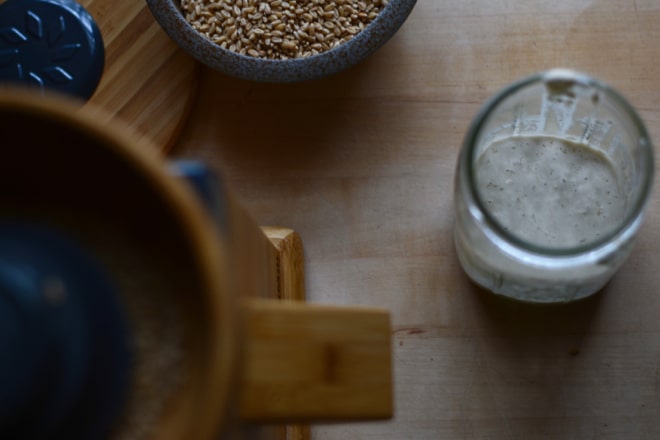
What wheat berries to NOT use for sourdough bread
Just like there are wheat berries that are best to use for sourdough bread, there are also some that you shouldn’t try using.
- Soft white wheat (too low in protein to allow strong gluten development)
- Soft red wheat (just like hard wheat, soft wheat has a white and red version)
- Rye (low gluten potential, resulting in dense, dry loaves)
- Any alternative grains like millet, sorghum, quinoa, barley, buckwheat, oats or teff.
What flour should I feed my sourdough starter?
Fresh flour sourdough starters seem to get mixed reviews. Some folks claim their starter is happier than ever with fresh milled flour, while other struggle to keep their starter alive and active on a fresh flour diet.
If you’re in the ladder category, try switching up what flour you’re feeding it. While, technically, a starter can live and thrive with just about any flour (including gluten-free grains for a GF sourdough starter!), there seem to be some grains starters prefer.
For me personally, my sluggish starter perked up when I switched it to rye flour. After experiencing that first-hand, I did some research. And it turns out that rye grains technically contain more yeasty-bacteria than other grains. This allows your sourdough starter to thrive just a bit more with rye flour than other flours.
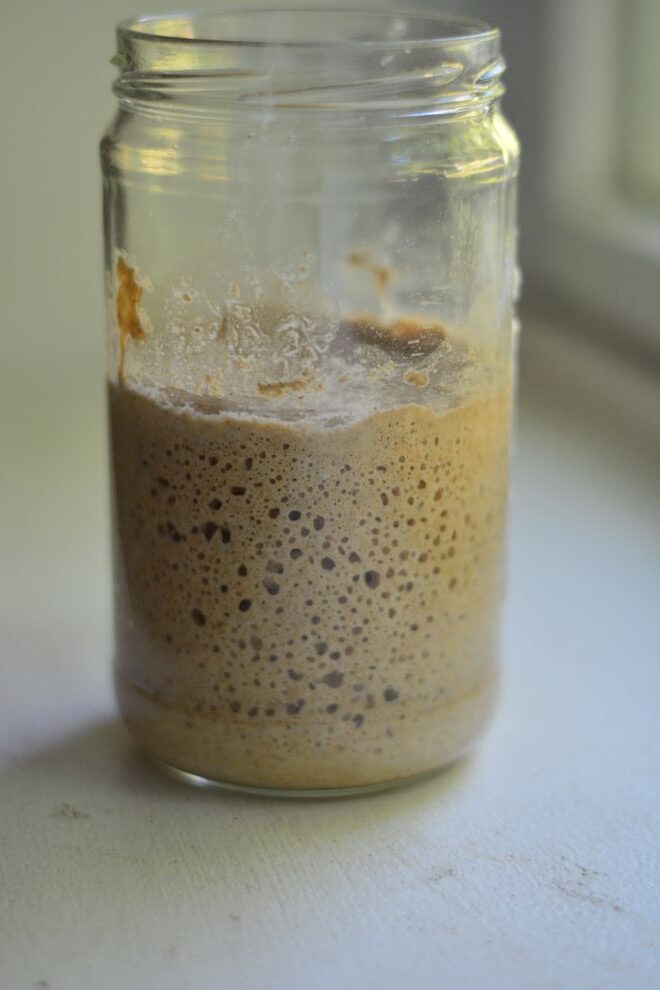
Troubleshooting fresh milled flour for sourdough bread
If you’re having trouble with your fresh milled sourdough bread made from wheat berries, you came to the right place. I used to be right there with you.
-> For starters, just keep practicing. Your bread will get better, I promise. Think of all this as a science experiment–that results in bread!
-> Try adjusting your timelines. Sometimes your bread will rise quicker, and other times it will need more time. Being flexible, especially as you’re getting into a groove, is crucial. Keep notes of what your timelines look like, so you remember later down the road.
-> Use different flour, and try using different ingredients. See what adding an egg does to your bread, or if adding vital wheat gluten helps your bread turn out better.
-> Try out different kneading techniques to find which ones work best for you. Traditional kneading, stretches and folds, coil folds, or even slap/folds like the bertinet method.

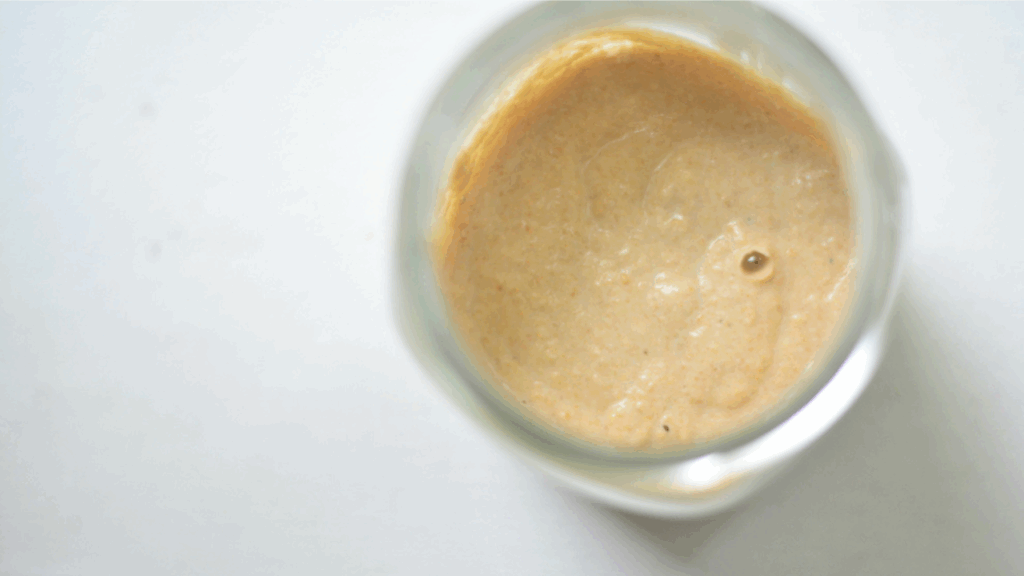
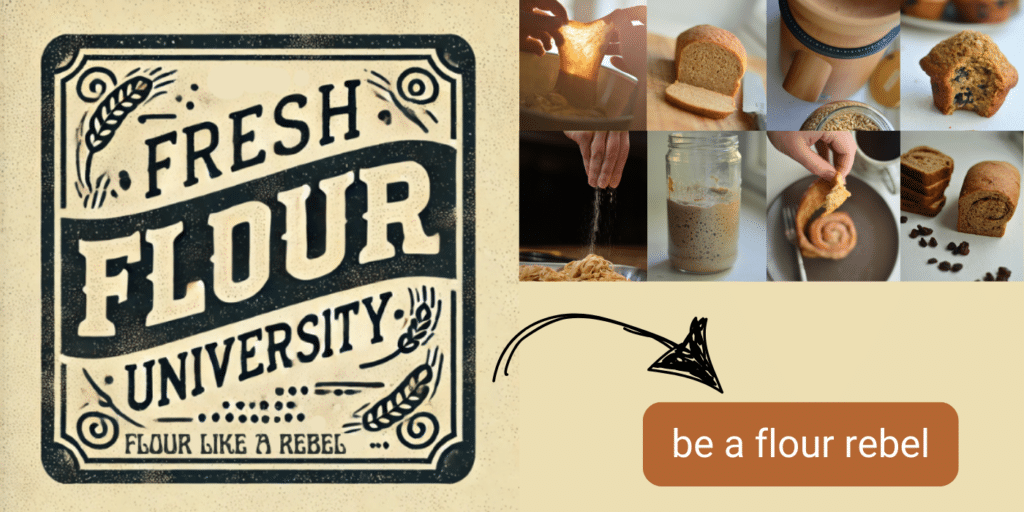
I’m intrigued with the idea of adding egg yolks to the sourdough. Can you tell the difference in flavor? I do love egg bread.
Shouldn’t change the flavor much, just make the crumb softer (more of an enriched texture)!
So helpful!! Excited to try this with my Mill I just got!! Eek!
I milled years ago and had a a classic nutri mill. Had to store it for a couple years due to personal issues and the mice chewed it . I wanted to give it to my daughter who recently is ALL in doing sourdough but the mill is unusable now😏
I would love to give this mill to her and enjoy watching her make healthy nutritious bread for her family.
Sourdough everything is so good for you. I love it!! The gut benefits are incredible. My sourdough starters name is miss bubbles!! 😃🩷 I do love her.
Haha! Great starter name!